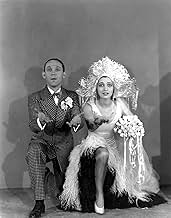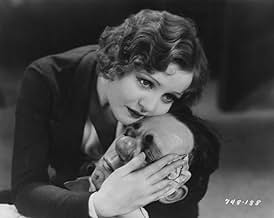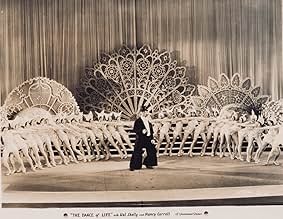अपनी भाषा में प्लॉट जोड़ेंWhen a vaudeville comic and a pretty young dancer have little luck in their separate careers, they decide to combine their acts; to save money on the road, they get married.When a vaudeville comic and a pretty young dancer have little luck in their separate careers, they decide to combine their acts; to save money on the road, they get married.When a vaudeville comic and a pretty young dancer have little luck in their separate careers, they decide to combine their acts; to save money on the road, they get married.
- पुरस्कार
- कुल 3 जीत
- Harvey Howell
- (as Ralph Theadore)
- Amazon Chorus Girl
- (as Miss La Reno)
- Amazon Chorus Girl
- (as Cora Beach Shumway)
फ़ीचर्ड समीक्षाएं
Protecting their investment further, four members of the original Broadway cast were recruited for the film version (the lead, Hal Skelly as "Skid", Ralph Theodore as Harvey, Charles D. Brown as Lefty and the great Oscar Levant in his first film role as Jerry the composer/pianist). Only the Broadway leading lady, Barbara Stanwyck as Bonny, Skid's lady love, was passed over for look-alike Nancy Carroll (rumor hath that Stanwyck's real life leading man declined to let her take the role unless he was hired too). Carroll was entirely fine in the role and Stanwyck followed to Hollywood shortly after.
The result for THE DANCE OF LIFE was one of the year's best films and the script, direction and cinematography hold up remarkably well after a little over 80 years, much better than some of the early full fledged "musicals" filmed at the time. This was not a traditional "musical" by Broadway or Hollywood standards, but a play in which a lot of music was intrinsic to the plot, and the musical numbers are as good a snapshot of what real live touring musical theatre looked like in 1929 as many an actual filmed musical show (like the Marx Brothers' COCOANUTS which was filmed at the end of its "subway circuit" tour out at the Astoria Studios in Astoria, Queens, New York). The borderline "beef trust" chorus girls marching in unison are a far cry from modern "choreography," but they breathe with the life of the world portrayed.
As good as the film is - and it is very good indeed, despite the often copied plot, remarkably faithful to the Broadway original, of the loyal girl protecting her talented but weak partner - no small credit is due to the superior cast. An Oscar Levant younger than most people today know him from his film roles of ten to twenty years later (THE BAND WAGON, opposite Nanette Fabray passing for a composer/lyricist team patterned after Betty Comden and Adolph Green is a classic), gives every indication of the indelible comic curmudgeon he would become, and Hal Skelly's Skid is a leading character actor for the ages. "Skid" would be a great performance in any age.
I haven't seen a naturalistic performance jump out of the more declamatory style performances around it with this much vivacity since Helen Hayes opposite Gary Cooper (three years later) in A FAREWELL TO ARMS. Hayes, of course, would go on to a brilliant career on stage and screen for another 50 years. Skelly might have, but after only a few more films and Broadway shows, while back East producing and starring in one of them (the ironically titled COME WHAT MAY) he lost his life when a car he was riding in was hit by a freight train in Connecticut. It was a greater loss to the stage and screen than those who have never seen his performance in this film (BURLESQUE was, with good reason, his greatest hit) can ever fathom.
I've never been able to find a copy of the brief VHS release noted elsewhere of the Paramount Picture, but until some wise soul finds a way to pry a pristine copy from the Paramount archives (one suspects the film may now be in the public domain if ANY copy could be found) to make it available to a new generation of film and theatre students who need to see the craft and passion involved, at least a decent copy can be viewed at Archive.org. It is essential viewing for any true student of the theatre or film. I'll be first in line to buy a copy when a DVD is available. Let's hope it's soon.
Curtis Stotlar
A big film in its time, Paramount popped for Technicolor and assigned it's two top directors, Cromwell and Sutherland. [The directors appear in cameos as doorman and theatre attendant, respectively.] Musical sequences are well done and entertain. Cringe factor on a one to five scale, one. The wonder of seeing the tall, lanky Skelly and diminutive Carroll dancing in perfect unison is still with me. They're the most unlikely team this side of Laurel and Hardy.
Many other splendid differences between this film and its contemporaries are worth noting. Released August, 1929, Paramount's superimposed credits seem so much more modern than the silent card graphics MGM still used. Not everyone cares to know who the associated producer is, we want entertained. Behind The Dance Of Life, silhouetted stage hands scurry about, pulling backdrops and riggings. You're treated to seeing behind the scenes while the obligatory texts play out. The ensemble cast has antagonists which prove to be red herrings. It's loaded with interesting camera compositions. A train is gained and quit at night in a pouring rainstorm. A sandwich is used as a romantic device. And what I enjoyed the most was the personal and up close feeling the directors give scenes. Skelly, after pratfalling from wing to wing, sings "True Blue Lou" so personally it would seem he was oblivious to the camera which closed in three times during the song.
A snapshot of a lost form of American entertainment, The Dance Of Life stands apart from its roots as a great film. See it!
If you're a weird masochists like me who like to torture yourself by watching early talkies, this will be a pleasant surprise for you. It feels like a big budget, high quality Paramount spectacular - a typical 1930s Hollywood movie - even though it's not actually a Hollywood movie. Paramount's new state of the art studio had just burned down so they had to relocate to their old New York studio for this.
Besides APPLAUSE and to a lesser extent THE LADY LIES and BROADWAY MELODY, most 1929 productions can only be viewed as interesting (or in most cases, boring) curios. This one however lets you sit back and, kick off your shoes and enjoy it as a proper picture. It's got proper modern style acting delivered with dialogue which sounds natural and authentic. The actors do what actors are meant to do: make you think they're real people.
One reason for this must attributed to David O'Selznick's decision to use two directors: one with a movie background and one with a theatre background - it works well. (David O'Selznick at Paramount? Working for MGM and RKO was clearly not enough for him!) The photography is as fluid and imaginative as it was before the restrictions of sound recording came in and the sound recording itself is superb. Also, another big plus is that although it's to some extent a romance, it is refreshingly not one of those nauseating, mushy, sickly sweet pictures which polluted our screens in the late twenties.
It's a bit longer than a typical early talkie but lovely Nancy Carroll thoroughly keeps your attention for the whole two hours. Like a lot of actors and actresses who became massively famous in early talkies, she virtually vanished after the mid thirties. You can understand that with many of those stars like Helen Twelvetrees for example who just didn't fit in with the style of filmmaking which the early talkies evolved into. With Nancy Carroll however it doesn't make sense because, certainly in this picture, she was so believable and engaging. She's not just beautiful and super-sexy like say Alice White, she's a real, normal person whom you think you might have gone to school with.
क्या आपको पता है
- ट्रिवियाOriginally intended as Paramount's first talkie, this production was transferred to the Astoria studios in Queens after the January '28 fire that destroyed Paramount's Hollywood studios. It was eventually transferred from Astoria back to Hollywood, incurring another delay, allowing several other features to be released before this film finally made it to theaters in mid-1929.
- भाव
Ralph 'Skid' Johnson: Say, you're out of a job--let's both wire him.
Bonny Lee King: Yeah, but I ain' got your talent.
Ralph 'Skid' Johnson: Aw, rats. With your face and figure, baby, you could make good anywhere.
- साउंडट्रैकTrue Blue Lou
(uncredited)
Music by Richard A. Whiting
Lyrics by Sam Coslow and Leo Robin
Sung by Hal Skelly
टॉप पसंद
विवरण
- चलने की अवधि1 घंटा 55 मिनट
- रंग
इस पेज में योगदान दें






























